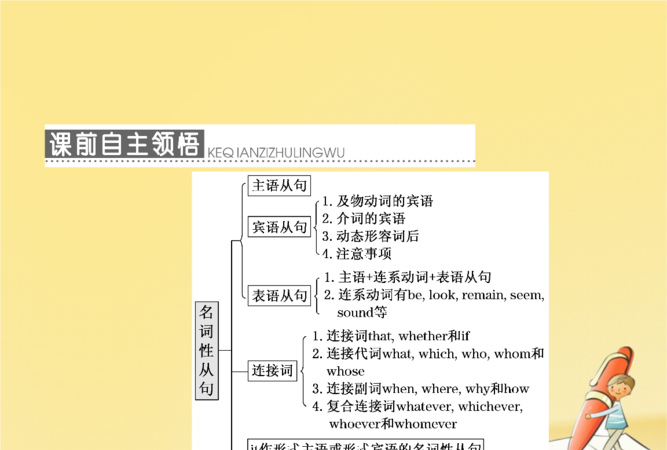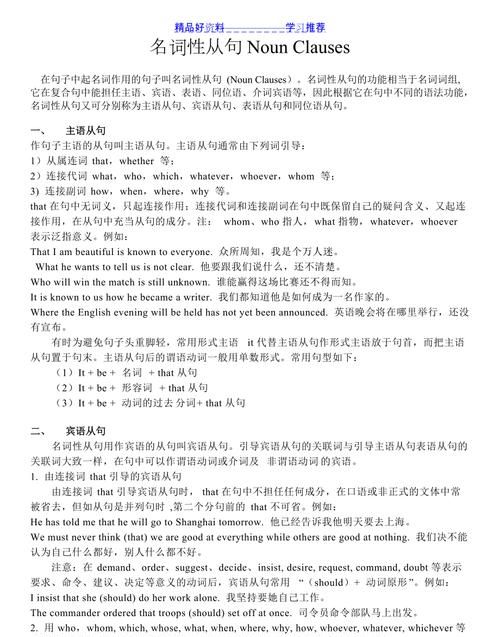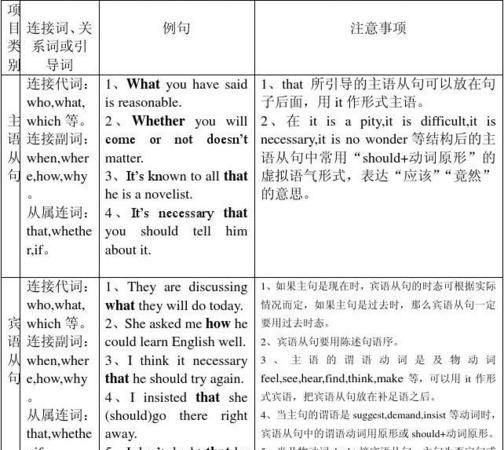本文目录
六年级下册英语语法知识点归纳
名词性从句相当于名词,可分别作主句的主语、表语、宾语和同位语。因此,名词性从句可分为主语从句、表语从句、宾语从句和同位从句。
一、引导名词性从句的连接词
1. 连接代词:who, whose, whom, what, which.有词义,在从句中担任成分,如主语、表语、宾语、或定语等。
2. 连接副词:when, where, why, how.有词义,在从句中担任成分,作状语。
3. 连接词:that, whether, if, as if.that 无词义,在从句中不担任成分,有时可省略;if (whether), as if虽有词义,但在从句中不担任成分。
注意:连接代词与连接副词在句中不再是疑问句,因而从句中谓语不用疑问式。连接代词与连接副词在从句充当句子成分,连接词whether 和if(是否),as if(好像)在从句中不充当句子成分,只起连接作用。根据句义,如果连接代词与连接副词,whether、if 和as if都用不上时,才用that作连接词(that本身无任何含义)。
二、主语从句
1. 主语从句在复合句作主语。
e.g. Who will go is not important.
2. 用it作形式主语,主语从句放在句末。
e.g. It doesn‘t matter so much whether you will come or not.
3. that引导主语从句时,不能省略。
e.g. That he suddenly fell ill last week made us surprised.
三、表语从句
1. 表语从句在复合句中作表语,位于系动词之后。
e.g. The question was who could go there.
2. 引导表语从句的连接词that有时可省去。
e.g. My idea is (that) we can get more comrades to help in the work.
四、宾语从句
1. 宾语从句在复合句中作宾语。引导宾语从句的连词that一般可省略。
e.g. I hope (that) everything is all right.
2. 介词之后的宾语从句,不可用which或if连接,要分别用what或 whether.
e.g. I’m interested in whether you‘ve finished the work……
I’m interested in what you‘ve said.
3. whether与if都可以引导宾语从句,常可互换。但下面情况不能互换。
(1)宾语从句是否定句时,只用if,不用whether.
e.g. I wonder if it doesn’t rain.
(2)用if 会引起误解,就要用whether.
e.g. Please let me know whether you want to go.(此句如果把whether改成if,容易当成条件句理解)
(3)宾语从句中的whether 与or not直接连用,就不能换成if;不直接连用,可换。
e.g. I don‘t know whether or not the report is true.
I don’t know whether/ if the report is true or not.
(4)介词后的.宾语从句要用whether引导。whether 可与不定式连用。whether也可引导主语从句、表语从句、同位语从句,还可引导让步状语从句,以上均不能换成if.但引导条件从句时,只能用if,而不能用whether.
e.g. It depends on whether we have enough time.
They don‘t know whether to go there.
Please come to see me if you have time.
五、同位语从句
同位语从句在句中作某一名词的同位语,一般位于该名词(如:news, fact, idea, suggestion, promise等)之后,说明该名词的具体内容。
e.g. I have no idea when he will be back.
The fact that he had not said anything surprised everybody.

名词性从句知识点笔记
名词性从句用法详解
来源:英语语法网
一、概说
名词性从句,即指性质相当于名词的从句,它包括主语从句、宾语从句、表语从句和同位语从句。从高考的考查的实际情况来看,名词性从句考得最多的是宾语从句,其次是主语从句,再次是表语从句,而同位语从句则很少考查。
二、名词性从句的一般引导词
1. 连接词 that 只起连接作用,没有任何意思,也不充当句子成分,在宾语从句中可省略,但引导其他名词性从句时通常不省略。如:
I hope (that) you enjoy your holiday. 希望你假期过得好。
That he likes you is very obvious. 很显然他喜欢你。
2. 连接词 whether 也不充当句子成分,但有自己的意思,表示“是否”;引导宾语从句时,可换成 if,但引导其他名词性从句时不能换成 if。
He asked whether [if] I would show him the way. 他问我是否可以给他带路。
Whether it will do us harm remains to be seen. 是否对我们有害还要看一看。(引导主语从句,不能用 if 代替 whether)
3. 连接代词 who(m), whose, which, what 等,均有各自的意义,在从句中作主语、宾语、定语等。如:
That’s why she wanted to leave. 这就是她想离开的原因。
When we arrive doesn't matter. 什么时候到没有关系。
Tell me which one you like best. 告诉我你最喜欢哪一个。
4. 连接副词 when, where, why, how 等,也各自有自己的意义,在从句中作状语。如:
The question is how we should carry out the plan. 问题是怎样执行这个计划。
When she’ll be back depends much on the weather. 她什么时候回来在很大程度上要看天气。
Why he did it will remain a puzzle forever. 他为什么这样做将永远是一个谜。
三、名词性从句的重要引导词
1. what 用于引导名词性从句是一个十分重要的引导词,它可引导主语从句、宾语从句和表语从句,但不用于引导同位语从句。它引导的名词性从句有两个意思是:一是表示“什么”,带有疑问意味;二是表示“…所…的”,相当于一个先行词后接一个关系代词。如:
I don’t know what you want. 我不知道你想要什么。
I don’t know what you want is this. 我不知道你所想要的是这个。
2. what 引导名词性从句时可用作限定词,其后修饰名词。如:
I gave him what books I had. 我把我所有的书都给他了。
He gave me what money he had about him. 他把身边带有的钱全给了我。
注:what 后的名词可以是复数名词或不可数名词,但通常不能是单数可数名词,并且后接不可数名词时,有时可有little修饰,两者的区别是:what+不可数名词=所有的都,what little+不可数名词=虽少但全部。如:
What friends she has are out of the country. 她有的那些朋友全在国外。
We gave him what (little) help we could. 我们给了他我们力所能及的帮助。
3. whoever, whatever, whichever 等也可引导名词性从句,其意分别为“所…的一切事或东西”、“任何…的人”、““…的任可人或物”等。如:
Whoever wants the book may have it. 任何人要这书都可拿去。
I’ll do whatever I can to help him. 我们将尽我们所能来挽救他。
Buy whichever is cheapest. 买最便宜的。
注意以下受汉语意思影响而弄错的句子:
任何人来都欢迎。
误:Who comes will be welcome. / Anyone comes will be welcome.
正:Whoever comes will be welcome. / Anyone who comes will be welcome.
另外,它们也可引导让步状语从句,其意为“无论…”、“不管…”,其意相当于 no matter who [what, which]。如:
Whatever happens, you must be calm. 不管发生什么情况,你都必须镇静。(whatever = no matter what)
He won't eat you, whoever he is. 不管他是谁,他也不能把你吃掉。(whoever = no matter who)
注:whoever 既用作主格也用作宾语;作宾语时不宜用 whomever,因为在现代英语中 whomever 这个已几乎废弃不用。
4. why 与 because 的用法区别。两者均可引导表语从句,但前者强调结果,后者强调的原因。如:
I had a cold. That’s why I didn't come. 我感冒了,因此我没来。
I didn’t come. That’s because I had a cold. 我没有来,那是因为我感冒了。
五、名词性从句的语序
名词性从句的词序与陈述句语序相同,尤其注意那些由连接代词who(m), whose, which, what 和连接副词 when, where, why 等引导的名词性从句,不要受它们在特殊疑问句中用法的影响而误用疑问句词序。如:
Why was she crying? 她为什么在哭?
I don’t know why he was crying. 我不知道她为什么哭。
六、名词性从句的时态问题
1. 当主句的谓语动词是过去式时,宾语从句若不是一个客观事实或真理,其谓语动词也必须用某种过去时态。如:
She said that she didn't want to know. 她说她不想知道。
I asked her whether she would agree. 我问她是否会同意。
2. when, if 这两个词既可引导名词性从句,也可引导状语从句。当它们引导名词性从句且表示将来意义时,要直接使用将来时态;但当它们引导状语从句且表示将来意义时,则必须用一般现在时表示将来意义。如:
I don’t know when he will come, but when he comes, I’ll call you. 我不知道他什么时候,但当他来的时候,我会打电话给你。
句中第一个when 引导的是宾语从句,故用将来时态表示将来意义;第二个when 引导的是时间状语从句,故用一般现在时表示将来意义。

英语语法名词性从句思维导图
英语语法名词性从句
引导这些名词性从句的关联词包括:

从属连词that, if, whether;
连接代词who, whoever, whom, whomever, which, whichever, what, whatever, whose;
连接副词where, when, why, how。
其中, 从属连词只起连接作用, 在从句中不充当任何句法成分,而连接代词和连接副词既起连接作用, 在从句中又充当一定的成分.
That Owen should have married his cousin is not at all surprising. (主语从句)
The fact is that he didn’t go to the dinner party. (表语从句)
I don’t know if he will attend the meeting. (宾语从句)
Have you heard the news that Mary is going to marry Tom? (同位语从句)
你听说玛丽要和汤姆结婚的消息了吗?(that引导同位语从句)
[提示]
在含有主语从句的复合句中, 为保持句子平衡, 常用it作形式主语,而将真正的主语从句置于句末.
It’s well-known that water is indispensable to life.(形式主语)
2. 为保持句子平衡, that引导的宾语从句也常用it代替, 而将真正的.宾语从句置于主句句末。这常常出现在主句有形容词或分词作宾语补足语的情况下。
He made it quite clear that he preferred to live here.
3. 从属连词whether和if都作“是否…”解, 但if不可引导主语从句和表语从句。whether可与or(not)连用, 而if不可以。
I don’t know whether (if) she is at home. Whether she comes or not makes no difference.
4. that和what引导名词性从句的区别: that在从句中不充当成分,而what在从句中充当一定的成分, 如主语、表语、宾语等。that可省略, what则不可省。
He always means what he says. She suggested (that) he do it at once.
5. 同位语从句大多由从属连词that引导, 常跟在下列名词后面, 如fact, idea, opinion, news, hope, belief等, that不可省。同位语从句一般用来解释说明这些名词的具体含义和内容。
We are familiar with the idea that all matter consists of atoms.
The news that we are invited to the conference is very encouraging.
;高中英语名词性从句和定语从句的语法总结详细一点
名词性从句是由if, whether, that 和各种疑问词充当连接词所引导的从句,其功同名词一样。
一.主语从句
主语从句是在复合句中充当主语的从句,通常放在主句谓语动词之前或由形式主语it代替,而本身放在句子末尾。
1. It 作形式主语和it引导强调句的比较
It 作形式主语代替主语从句,主要是为了平衡句子结构,主语从句的连接词没有变化。而it引导的强调句则是对句子某一部分进行强调,无论强调的是什么成分,都可用连词that。被强调部分指人是也可用who/whom。
2. 用it 作形式主语的结构
(1) It is +名词+从句
(2) it is +形容词+从句
(3) it is +不及物动词+从句
(4) it +过去分词+从句
3. 主语从句不可位于句首的五种情况
(1) if 引导的主语从句不可居于复合句句首。
(2) It is said , (reported) …结构中的主语从句不可提前。
(3) It happens…, It occurs… 结构中的主语从句不可提前。
(4) It doesn’t matter how/whether …结构中的主语从句不可提前。
(5) 含主语从句的复合句是疑问句时,主语从句不可提前。
4. What 与that 在引导主语从句时的区别
What 引导主语从句时在句时在从句中充当句子成分,如主语.宾语.表语,而that 则不然。
定语从句也称为关系从句或形容词性从句,由关系代词(who, whom, whose, which, that)或关系副词(as, when, where, why)等引导。关系词除了起引导作用外,还在从句中指代前面的先行词,并在从句中担任一定的成分。
一、限定性定语从句和非限定性定语从句
定语从句就其与先行词的关系而言,可分为限定性定语从句和非限定性定语从句。限定性定语从句和先行词之间没有逗号,表示对先行词起修饰限制作用;而非限定性定语从句和先行词之间有逗号分开,是对先行词进行补充说明,相当于并列句。如:
He is the man who has strong personality. 他是个个性很强的人。(限定性定语从句)
My brother, who works abroad, is coming next week. 我哥哥在国外工作,他下周将回来。(非限定性定语从句)
注:1. 非限定性定语从句不能用that来引导,一般用which,as或who(指人)。用which或as引导时,既可以修饰主句的部分内容,也可修饰主句的全部内容。如:
He spoke confidently, which impressed me most. (which指代整个主句,在从句中作主语)
2. as引导的非限定性定语从句既可以放在主句之前,也可以放在主句之后,但which或who引导的非限定性定语从句不能放在主句之前。如:
As we all know, the moon is a satellite of the earth.
The large area is covered with thick snow, which affects people's life greatly.
3. 在限定性定语从句中,关系代词作宾语时可以省略;但在非限定性定语从句中,关系代词作宾语时不能省略。如:
The film (which) I saw last night is about a young teacher. (which可以省去)
She introduced me to her husband, whom I hadn’t met before. (whom不能省去)
二、通常只用关系代词that,不用 which,who或whom的几种情况
1. 当先行词是all, everything, nothing, something, anything, little, much, none, few等时。如:
All that you want are here.
2. 当先行词被all, no, some, any, every, a few, a little, much, only, very等修饰时。如:
There is no person that doesn’t make mistakes.
3. 当先行词被序数词或形容词最高级修饰时。如:
This is the best film that I have ever seen.
4. 当出现两个或两个以上的先行词,并同时兼指人和物时。如:
We are talking about the people and countries that we have visited.
5. 当主句是以which 或 who 开头的特殊疑问句时。如:
Who is the person that is standing over there?
6. 当定语从句为there be 句型时,关系代词只能用that,但经常可以省略。如:
I know the difference (that) there is between you.
7. 当关系代词在从句中作表语时,常用that。如:
He does not seem to be the man that he was. 他似乎和过去不一样了。
三、as 与其他词连用引导的定语从句
as 引导定语从句时,可指人也可指物,通常与the same,such,so等连用,形式为:the same… as,such… as,as …as,so… as。As在定语从句中可作主语、宾语、表语等。如:
She knew he felt just the same as she did. 她知道他的感觉与她自己的一样。(as代替事,作宾语)
I lend you such books as will interest you. 我借给你使你感兴趣的书。(as代替物,作主语)
注:the same… as 和the same… that的用法不同。as引导的定语从句表示其内容与主句所讲的事物“相似”,指同类事物;that引导的定语从句表示其内容与主句所讲的事物是“同一个”,指同一事物。如:
This is the same pen as I lost yesterday. 这和我昨天丢的笔一样。(类似的笔)
This is the same pen that I lost yesterday. 这支笔就是我昨天丢的那支。(同一支笔)
四、“介词+关系代词”引导的定语从句
在“介词+which/whom”结构中,介词的选择取决于三种情况:
1.定语从句中谓语动词或表语的搭配。如:
This is the college in which I am studying.
He is the man about whom we are talking.
2.先行词与介词的习惯搭配。如:
The speed at which the machine operates is shown on the meter. 仪表上显示出这台机器运转的速度。
3.当定语从句为最高级时只能用of which; 否则用其他介词。如:
I have five dictionaries of which Longman Dictionary is the best.
I have five dictionaries among which Longman Dictionary is published in UK.
注:不可拆分的动词短语介词不能提前,如put up with;有的短语可能有不同的介词搭配,此时需要根据上下文来确定。如:be familiar with/to,compare with/to等。
有时为表意清楚,还可以在关系副词where/ when前加介词from, to等。如:
China is the birthplace of kites, from where kite flying spread to Japan, Korea, Thailand and India. 中国是风筝的故乡,从这里,放风筝的运动传到了日本、韩国、泰国和印度。

以上就是关于英语名词性从句总结 ,六年级下册英语语法知识点归纳的全部内容,以及英语名词性从句总结 的相关内容,希望能够帮到您。

